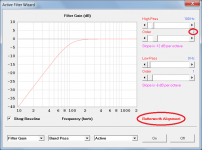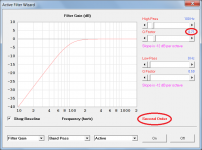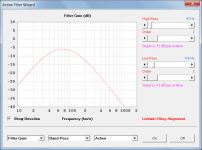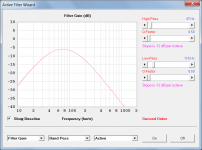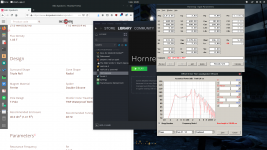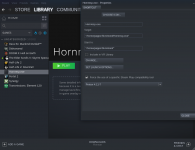Be aware that the driver electromagnetic coupling invert impedances, so a mechanical or acoustic inductance (mass) will show up as a capacitance in the electrical impedance, and vice versa.
You can see an example of this in David's impedance plot above. Below resonance, the driver is stiffness controlled, i.e. a mechanical capacitance, but the phase of the electrical impedance is positive, i.e. the electrical impedance is inductive.
This can be somewhat confusing. But if you are using impedance to check adjust your design, it can be useful to keep in mind.
You can see an example of this in David's impedance plot above. Below resonance, the driver is stiffness controlled, i.e. a mechanical capacitance, but the phase of the electrical impedance is positive, i.e. the electrical impedance is inductive.
This can be somewhat confusing. But if you are using impedance to check adjust your design, it can be useful to keep in mind.
So is it the final countdown? Monday....
For Amazon.co.uk at least. But it is available here at the moment.
I'm buying a copy of the book. From long experience I understand how much work has been put into this. It will be greatly appreciated.
Thanks. It's been a massive undertaking. Hope you will find it useful 🙂
@Kolbrek, that second site seems to have a currency conversion problem with Dollars. It seems more reasonable if you select Euro or Pounds.
This addresses the confusion I was having with the phase responses. Thanks!Hornresp Update 5050-191023
CHANGE 1
The polarity assumed for an individual output in a multiple output system is now shown on the phase chart for that output.
…
CHANGE 3
The path length value has been removed from the combined response phase and group delay chart captions so as not to imply that the path length is included in the phase and group delay calculations. The charts now also indicate that the combined response is being shown.
Much appreciated! 🙂CHANGE 4
Loudspeaker wizard dipole pressure response chart results can now be exported.
Whooo... orderd my copy, looking forward to it 🙂
I'm trying...
They do not have simple shipping to Canada. In fact there is no where in their system for me to really input the correct address.🙁
So I send an email. I'll report back 🙂
Had a pleasant email exchange with the UK vendor and I'm awaiting the delivery of my copy. Thanks again to you two gentlemen for the enormous amount of working creating such a reference.
Very happy to hear my copy is now being shipped !
( more accurately 'lorried' ! )
Looking forward enormously to reading this.
( more accurately 'lorried' ! )
Looking forward enormously to reading this.
Hello, Can I ask. In the Filter Wizard Settings.
I have used a Second Order Filter. Is this the same as a Butterworth Filter with an order of 2?
I have designed a folded horn/ Ported Cabinet and have to apply filters to reduce the Diaphram Displacement.
How can I replicate this filter for the sound test I am going to be doing on the Cabinet.
Thanks
I have used a Second Order Filter. Is this the same as a Butterworth Filter with an order of 2?
I have designed a folded horn/ Ported Cabinet and have to apply filters to reduce the Diaphram Displacement.
How can I replicate this filter for the sound test I am going to be doing on the Cabinet.
Thanks
Hi Andypk,
A Second Order Filter with a Q Factor of 0.71 (1 / Sqrt(2)) is the same as a Butterworth Filter with an order of 2.
I will leave this for someone else to answer 🙂.
Kind regards,
David
I have used a Second Order Filter. Is this the same as a Butterworth Filter with an order of 2?
A Second Order Filter with a Q Factor of 0.71 (1 / Sqrt(2)) is the same as a Butterworth Filter with an order of 2.
How can I replicate this filter for the sound test I am going to be doing on the Cabinet.
I will leave this for someone else to answer 🙂.
Kind regards,
David
Attachments
Thank you for your reply. Your application is amazing. See this post if you are interested.
Folded Horn/Bandpass 15" Design Pics. - Speakerplans.com Forums - Page 4
The only way to get the cab to function is "Second Order" with a Q factor of .5
Thank you.
Xover 3 Pro might be an option. Or getting an internal xover made up.
Folded Horn/Bandpass 15" Design Pics. - Speakerplans.com Forums - Page 4
The only way to get the cab to function is "Second Order" with a Q factor of .5
Thank you.
Xover 3 Pro might be an option. Or getting an internal xover made up.
Thanks. I can control the Q in most Music Production Software Filters I think.
Thanks for your help. Hornresp is amazing.
I have a Q of .5 as second order. This is the best result for a Vented Rear chamber Folden Horn Design to reduce the xmax.
Thanks for your help. Hornresp is amazing.
I have a Q of .5 as second order. This is the best result for a Vented Rear chamber Folden Horn Design to reduce the xmax.
The only way to get the cab to function is "Second Order" with a Q factor of .5
Not sure if it helps, but a Linkwitz-Riley Filter with an order of 2 is the same as a Second Order Filter with a Q Factor of 0.50.
Attachments
For Amazon.co.uk at least. But it is available here at the moment.
Thanks. It's been a massive undertaking. Hope you will find it useful 🙂
I just received the book. Ordered it only 3 days ago from Lean Business Audio. It required an email with them since I am in the USA. No one should have any qualms about this purchasing process
- Home
- Loudspeakers
- Subwoofers
- Hornresp
